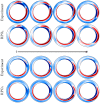Turbulence tracks recurrent solutions
- PMID: 35984901
- PMCID: PMC9407532
- DOI: 10.1073/pnas.2120665119
Turbulence tracks recurrent solutions
Erratum in
-
Correction for Crowley et al., Turbulence tracks recurrent solutions.Proc Natl Acad Sci U S A. 2022 Nov 8;119(45):e2216896119. doi: 10.1073/pnas.2216896119. Epub 2022 Nov 2. Proc Natl Acad Sci U S A. 2022. PMID: 36322774 Free PMC article. No abstract available.
Abstract
Despite a long and rich history of scientific investigation, fluid turbulence remains one of the most challenging problems in science and engineering. One of the key outstanding questions concerns the role of coherent structures that describe frequently observed patterns embedded in turbulence. It has been suggested, but not proved, that coherent structures correspond to unstable, recurrent solutions of the governing equation of fluid dynamics. Here, we present experimental and numerical evidence that three-dimensional turbulent flow tracks, episodically but repeatedly, the spatial and temporal structure of multiple such solutions. Our results provide compelling evidence that coherent structures, grounded in the governing equations, can be harnessed to predict how turbulent flows evolve.
Keywords: coherent structures; nonlinear dynamics; prediction; turbulence.
Conflict of interest statement
The authors declare no competing interest.
Figures








References
-
- Kolmogorov A. N., The local structure of turbulence in incompressible viscous fluid for very large Reynolds numbers. Cr. Acad. Sci. URSS 30, 301–305 (1941).
-
- Taylor G. I., Statistical theory of turbulence. Proc. R. Soc. Lond. Ser. A Math. Phys. Sci. 151, 421–444 (1935).
-
- Moody L. F., Friction factors for pipe flow. Trans. Asme 66, 671–684 (1944).
-
- Smits A. J., McKeon B. J., Marusic I., High–Reynolds number wall turbulence. Annu. Rev. Fluid Mech. 43, 353–375 (2011).
Grants and funding
LinkOut - more resources
Full Text Sources

